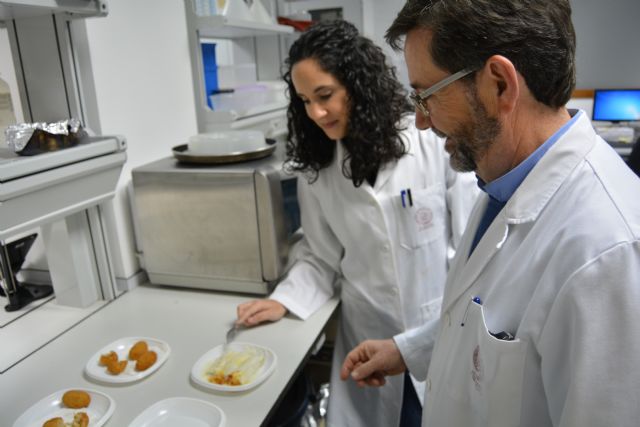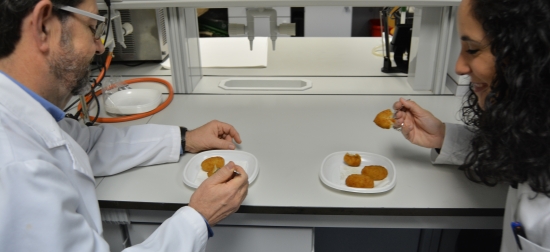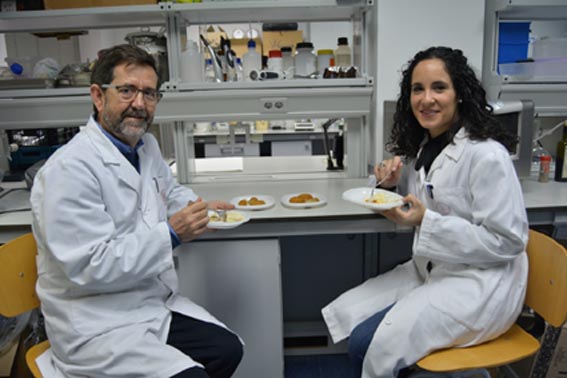Yesterday, in the morning, I was listening the radio and the presenter of the programme interviewed two scientists, from the University of Cartagena, who talked about food related to the Celiac disease.
Researchers from the Department of Food Engineering of the Polytechnic University of Cartagena (UPCT) have won two patents, that lower the cost of industrial production of pre-cooked meals gluten-free. The research was based on the croquettes and pasta dishes: cannelloni, lasagna, spaghetti and macaroni.

The Professor Antonio López and the Agronomist Sonia Soto tasting some cannelloni

Antonio López and Sonia Soto tasting croquettes

Antonio Lopez and Sonia Soto eating cannelloni
Today, the dishes prepared gluten-free cost the double that conventional ones and their quality is improvable. "One of the challenges of the food industry is to reduce their costs and improve their taste and nutritional quality, to reach growing number of consumers", said Antonio López, responsible researcher.
One of the advantages of the new manufacturing technique of croquettes gluten-free is absorbing half of oil than conventional ones, when fried; "so, they are softer and healthier, they are not too heavy and you want to keep eating", says Antonio Lopez. Another advantage is the quality and taste, which greatly improves over croquettes gluten-free, that are currently on market. So, they are appealing for any type of consumer, whether or not celiac.
The researchers, at the School of Agronomists, have achieved an adequate texture, in the dough of croquettes, to handle it industrially. "The gluten gives strength and consistency to the mass of croquettes, providing a good viscoelasticity, when wheat flour is used. During its industrial production, dumplings are formed and they fall, at high speed, and if they have not the right texture, they remain flat, as cookies", López added. Therefore, researchers have had to replace the wheat flour of the white sauce by rice flour and other components, that achieve a similar texture to the dough. The breadcrumbs of these croquettes are also gluten-free and developed specifically for a breading of adequate quality.
The research group has made possible the industrial management of dough of pasta gluten-free in sheets.
"The manufacturers made large sheets, which can exceed 15 metres long and 50 centimetres wide and just over 1 millimeter thick and, if the mass does not include gluten, they break themselves", Lopez explains. This causes the gluten-free pasta in sheets are currently manufactured, almost by hand, so the prices of the relevant prepared dishes are very high. With the new technique of industrial production of gluten-free pasta in sheets can reduce costs considerably.
Making croquettes and pasta gluten-free is focused on frozen ready meals sector, but also can be refrigerated.
The patents, called "Composition and method of making breaded foods with low oil absorption during frying" and "Composition and procedure for industrial processing of gluten-free pasta in sheets", have been generated in the doctoral thesis, defended by Sonia Soto Jover, agronomist and Master of Advanced Techniques in Research and Agricultural Development and Food, qualified with full marks (cum laude). Part of the conclusions of the thesis were published in two prestigious international journals on Technology and Food Engineering: “Food Engineering Reviews” and “LWT - Food Science and Technology”.
They explained, in the interview, they were researching from 2010 to 2014.Then, from 2014 to 2015, they were preparing the patents. And now, from 2015, they are searching a company, which is able to take these products to market.
The research was led by the Professor, Antonio Lopez Gomez, and have collaborated the teachers Arturo Esnoz and Asuncion Iguaz, and the researchers Sonia Soto and María Boluda.
Gluten is found in wheat, barley and rye, three foods that are grown from about 10,000 years ago. In the last decade, the number of people to avoid this protein complex, present in cereals, is on the rise. Approximately between 1 and 5% of the population suffers the celiac disease. Therefore, increasingly, the major manufacturers of food are changing their recipes, to attend to this demand.
Well, I hope that they find a company, as soon as possible, to help many people with this disease.
Until my next post, kind regards,
Luis.
Sponsored by Costaluz Lawyers.
Please click below:
